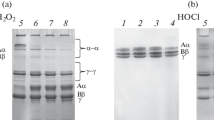Summary
It was discovered that ethylene diamine tetra-acetic acid (EDTA), by lowering the pH to near 5.0, caused fibrinogen to be precipitated out of solution in heparinised plasma.
The optimum pH for the precipitation of fibrinogen by heparin was found to be 4.8 Calcium ions assist in this reaction.
A 3.5?/o solution of polyvinyl pyrrolidone (PVP) increased the precipitation of filbrinogen ,by heparin at pH 4.8 but, in the absence of heparin, did not precipitate fibrinogen.
The amount of fibrinogen precipitated by heparin at pH 4.8 was increased in the malignant, infective and “collagen” disease groups. A possible explanation for this phenomenon is discussed.
Similar content being viewed by others
References
Braunsteiner, H., Sailer, S., and Weippl, W. (1957).Blut, 5, 149.
Fischer, A. (1931).Biochem. Z., 240, 364.
Fletcher, F., Martin, L. E., and Ratcliffe, A. (1952).Nature, 170, 319.
Godai, H. (1960).Scandav. J. Clin. & Lab. Invest., 12, 56.
Godai, H. (1961).Scandav. J. Clin. & Lab. Invest., 13, 550.
Jorpes, J. E. (1946).Heparin in the Treatment of Thrombosis. Oxford Univ. Press, p. 47.
Lepage, F., Eyquem, A. and Petit, P. F. (1952).Rev. Haemat., 7, 72.
Miller, D. (1960).Blood, 16, 1313.
Scott, J. S. (1955).Brit. Med. J., 2, 290.
Seegers, W. H., Neift, M. L., and Vandenbelt, J. M. (1945).Arch. Biochem. Biophys., 7, 15.
Smith, R. T. (1967).J. Clin. Invest., 36, 605.
Smith, R. T. and Von Korff, R. W. (1957).J. Clin. Invest., 36, 596.
Temperley, I. J. (1963).In the press.
Ziff, M.,and Chargaff, E. (1940).J. Biol. Chem., 135, 689.
Author information
Authors and Affiliations
Rights and permissions
About this article
Cite this article
Temperley, I.J. The precipitation of fibrinogen by heparin at ph 4.8. I.J.M.S. 38, 159–166 (1963). https://doi.org/10.1007/BF02947195
Published:
Issue Date:
DOI: https://doi.org/10.1007/BF02947195




